While relatively easy to learn the basic rules of contract bridge, it can take quite some time to master. Contract bridge is played with the standard 52 card deck, with the cards ranked in the following, descending order: A, K, Q, J, 10, 9, 8, 7, 6, 5, 4, 3, 2.
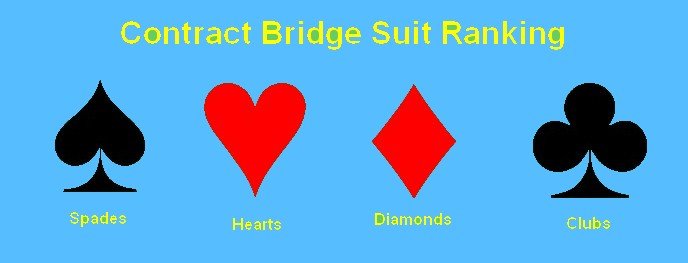
Standard contract bridge is always played by four players, with two of the players playing as partners playing against the other two who are also partners. Each player will remain partnered with the same player throughout the entirety of the game. For variations of Contract Bridge for differing numbers of players, see the Variations section below.
Oftentimes, in this game the partnerships may be pre-arranged, especially amongst regular players. Otherwise, to determine the partnerships and the first dealer, the fully shuffled deck should be fanned out in the center of the table, face down. Each player then draws one card from the deck, but not one of the last four cards at either end of the spread out deck. The two highest ranked cards (see above for ranking of specific cards and suits) play as partners against the two lowest. The player who draws the highest card becomes the dealer for the first hand of the game.
Each player sits at the table directly opposite their partner such that the play will alternate between each partner. In bridge the seats are indicated by the four compass directions, North, South, East and West. Thus, player "North" sits opposite his partner "South" and "East" sits across the table from "West" who plays as his partner. The first dealer generally sits in the North position.
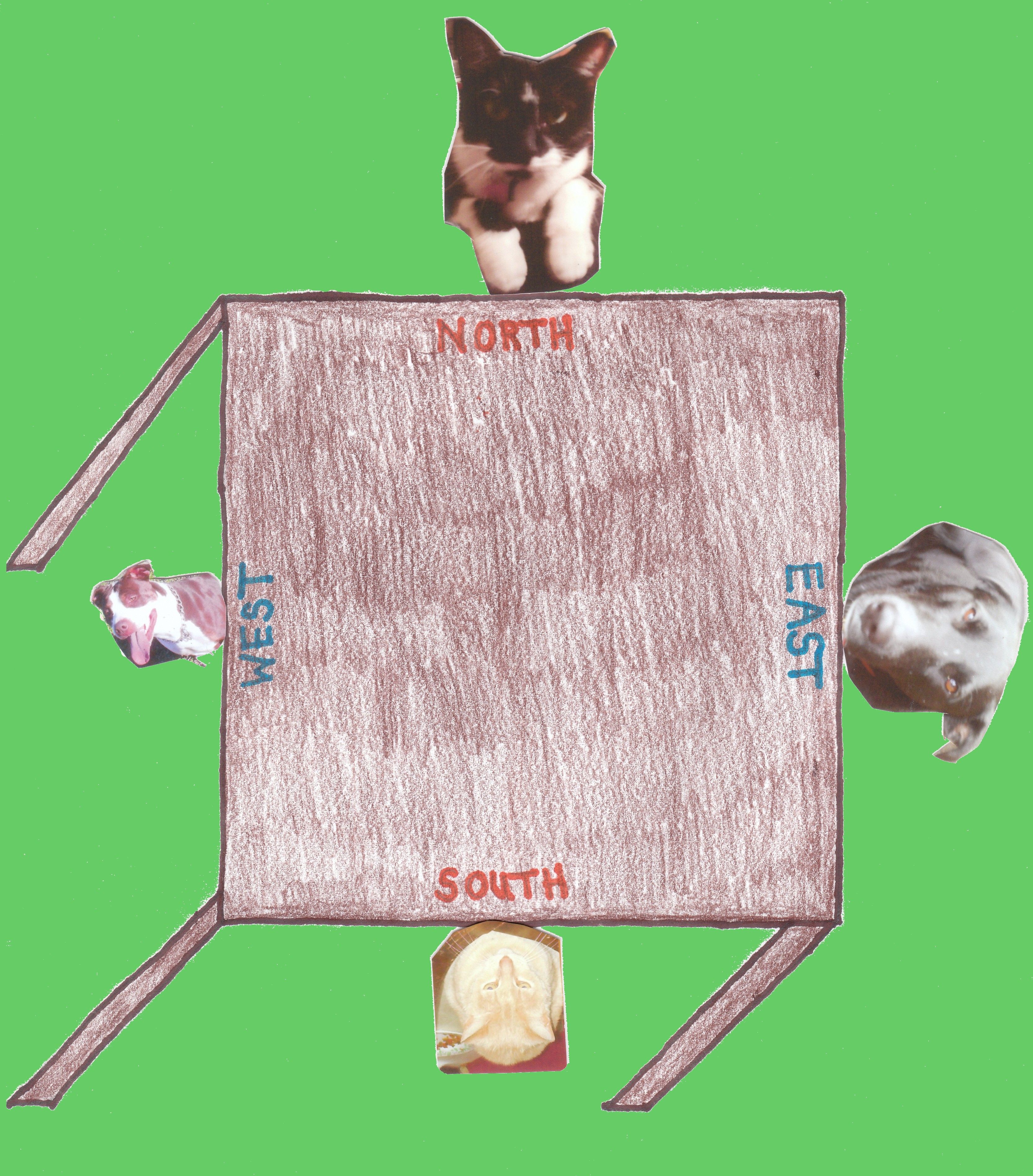
| |
North and South will thus play in partnership against the second partnership which consists of the players seated at positions East and West. |
The pack is then shuffled by the player to dealers left and cut by the player to dealers right. The dealer then takes the deck and deals out one card at a time, face down to each player, starting with the player to his immediate left in a clockwise direction. He deals out the entire deck, with each player receiving thirteen cards. The right to deal each hand then passes clockwise around the table, with the next dealer being the player at the current dealers immediate left.
Bidding and the Auction
After each player examines his hand, the Auction begins. The auction begins with the dealer and continues clockwise around the table. On his turn at bidding, a player must make one of the following calls:- Pass: A player not wanting to bid, double or redouble, may call "Pass". If the first four calls in the hand are all "pass" the cards are gathered together and the deal passes to the next player with no play or scoring occurring for this deal.
- Bid: The player, on his turn may make a bid representing a number of odd tricks. These odd tricks bid, are the number of tricks, over 6, that the bidder is contracting to win in the course of this hand. Along with his bid, he also names a specific suit to be the trump suit for the hand. Thus, a bid of three would indicate the player is declaring to win nine tricks in this hand (6 base tricks + bid of 3 = 9 total tricks). A bid can only be made if the bidder names a higher number of tricks than any previous bid or if he names an equal number of tricks to the previous highest bidder but calls a higher ranking suit (see suit ranking above) as the trump suit. A bid may also be made at "No Trump" which indicates the hand will be played with no trump suit at all. A "No Trump" bid outranks all other suited bids of the same number.
- Double: A player, on his turn to bid, may call "Double" if the last highest bid was made by a member of the opposing partnership. If the original bid that the player called "Double" on becomes the winning bid, that previous bid still determines which player becomes the declarer, the number of odd tricks to be won and the trump suit for the hand, however, all scores and penalties for odd tricks, undertricks and overtricks (see scoring below) are doubled. A "Double" call can be over bid by any legal bid that is higher than the previous, high call (either through a higher number of tricks or a higher trump suit declaration). In this event the double call is canceled, unless the higher bid is also doubled.
- Redouble: A "Redouble" can only be called if an opponent has called "double" on the current high bid. This current high bid must have been made by your partnership. A redouble again doubles the scoring and penalties for overtricks, undertricks and odd tricks. Similar to a call of "Double", a "Redouble" is overbid by any bid which would normally overcall the originally "Doubled" bid, which then cancels the "redouble" unless, through the bidding the new high bid again becomes redoubled.
| Bidding Example | |||
|---|---|---|---|
| South | West | North | East |
| Pass | 1 ♣ | Pass | 1 ♦ |
| Pass | 2 No Trump | Double | Pass |
| 2 ♠ | 3 ♦ | 3 ♠ | Pass |
| Pass | Pass | - | - |
| In this example, the dealer, South declines to start the bidding, with a pass. West bids the minimum bid of one club. North passes and East follows with a bid of one diamond. South passes and West increases the bid to 2 with no trump suit. North responds with a call of Double (whereas West's bid would remain the highest bid, but certain scores for the hand would be doubled). East passes and South, the dealer bids 2 spades which also cancels North's Double (although any player could again double the current high bid). West overcalls this bid with 3 diamonds and North responds with a bid of 3 spades. East, South and West all pass, thus three spades becomes the winning bid with spades as trump. Since North was the first player of his partnership to declare spades in a bid, he becomes the declarer and plays the hand for his partnership attempting to win a total of 9 or more tricks. | |||
As bidding is one of the most complex components of the game of Contract Bridge, there are a number of standard bidding methodologies commonly used. These methodologies are generally designed to not only convey some information about your hand (through the various bids) to your partner, but also to complete the bidding (if you are the contract winner) with a bid in suit and number that the partnership can use to win the hand. All bidding techniques to be used by a partnership must be explained and discussed with the opponents before the game, and direct communications about the contents of a players hand are never allowed.
In fact, the major goal in the earlier bids in the round are simply to advertise information about your own hand and request information, through these same bidding conventions, about your partners hand. Before beginning their bidding players will thus evaluate their hands through a number of means, with the Goren point count system being the most commonly used in most social games of bridge. The bidding example above is not intended to so much illustrate anything about the players hands but more to show how the general flow of bidding in contract bridge might proceed.
Gameplay
Once the "declarer" and trump suit (if any) are determined as per the auction (see above) the play of the hand begins. The declarer attempts to win at least as many odd tricks as their final bid while the opposing partnership attempts to win as many tricks as possible in an effort to prevent the declarer from fulfilling the contract.
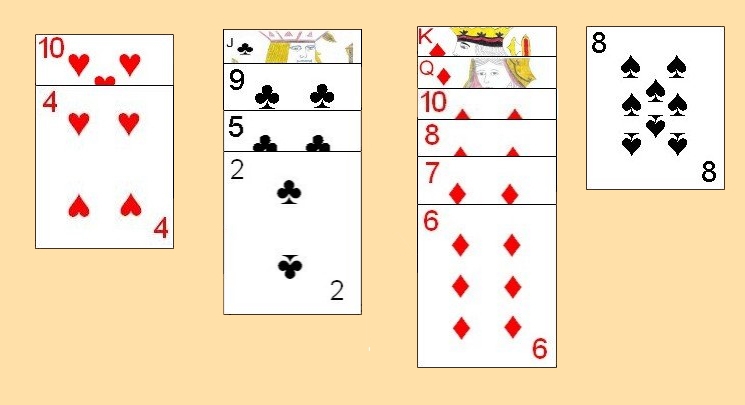
|
| The dummy hand should be laid out in an ordered fashion for ease of play by the bidder. |
Scoring
A typical score sheet for Bridge has two scoring sections for each partnership, called "above the line" scores and "below the line" scores. Each scoring category, detailed below, is scored in one or the other locations.- Tricks bid and won:
If the declarer has won the requisite number of tricks (six plus the number of tricks they bid for the winning contract) they score dependent on number of tricks and trump suit (if any) for the hand, using the following table:
This score is Doubled if the contract was "doubled" (see bidding section above).Suit Odd tricks Bid and Won 1 2 3 4 5 6 7 Spades(♠)/Hearts(♥) 30 60 90 120 150 180 210 Clubs(♣)/Diamonds(♦) 20 40 60 80 100 120 140 No Trump 40 70 100 130 160 190 220
If the contract was "redoubled", the score in the chart should be Quadrupled.
These trick scores are scored "below the line" for the declarers partnership.
- Overtricks:
For every trick won beyond six plus their bid, the declarers partnership scores as follows (these extra tricks are called overtricks):
If the contract was doubled each of these overtricks, regardless of the trump suit, is scored 100 points. If the partnership winning the deal is vulnerable (see below) they score 200 per overtrick instead.Suit Score Spades(♠)/Hearts(♥) 30 Clubs(♣)/Diamonds(♦) 20 No Trump 30
For a redouble, these tricks are scored at 200 points when not vulnerable and 400 when vulnerable.
All overtrick scores are scored "above the line" for the partnership winning them.
- Undertricks (Scored for Defenders):
If, however the defenders are able to prevent the declarer from winning six plus their bid in odd tricks, they are set and the defenders score as per the following tables for each trick short of their total bid plus six:
This score, which is earned by the defending team, is scored "above the line".Partnership Not Vulnerable First Additional Standard Bid 50 50 Doubled Contract 100 200 Redoubled Contract 200 400 Partnership Vulnerable First Additional Standard Bid 100 100 Doubled Contract 200 300 Redoubled Contract 400 600
- Double/Redouble bonus:
If the declarer is able to fulfill a "doubled" or "redoubled" contract they score 50 points. This score is added in the "above the line" scoring section for the partnership.
- Honors:
If any player (including the dummy hand) holds any four of the following cards in the suit chosen as the trump suit for the hand (Ace, King, Queen, Jack, Ten), his partnership earns 100 points, above the line. These five trump cards are called the Honors. If any player holds all five of these honors, his partnership scores 150 points "above the line". If the hand is being played at No Trump, the four aces are considered the Honors and any player holding all four earns a 150 point bonus "above the line".
- Little Slam:
If the declarer is playing a contract to win 6 odd tricks (12 total tricks) and he is able to fulfill the contract he has made a little slam and his partnership earns a bonus of 750 points if vulnerable and 500 if not vulnerable. This score is added in the "above the line" section of the scorecard.
- Grand Slam:
If the declarer has bid for and wins 7 (every trick in the hand) they have completed a grand slam. A grand slam scores 1,500 for the partnership if they are vulnerable and 1,000 if not vulnerable. As in a little slam, this score is added "above the line".
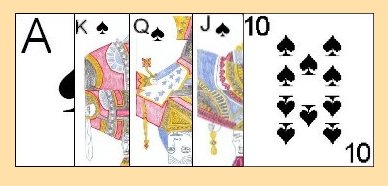
|
| Potential Honor cards if Spades were the trump suit for the hand. |
Winning a "Game"
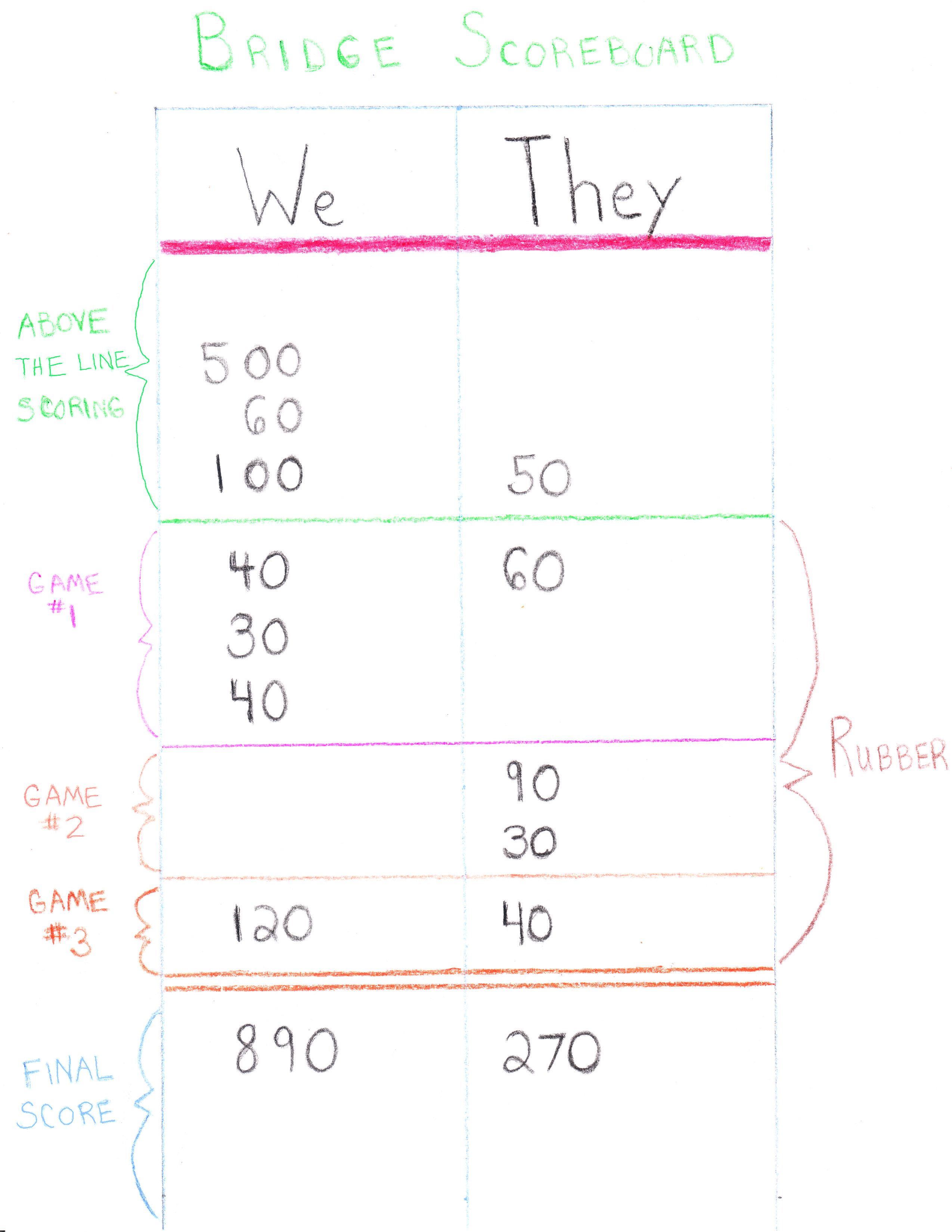
|
| This sample Contract Bridge Score sheet shows the typical layout and locations for possible scoring areas during the game. The individual sections have been labeled to show where the different scores should be recorded. Notice the separate sections for Above the line, Individual game sections and the Final Score given at the bottom of the sheet. |
The first partnership to win two "games" in this manner wins a "rubber". The partnership winning the rubber earns a 500 point bonus above the line. If, however, the opposing partnership have not won any games during the rubber, the winning partnership score 700 points instead.
Once one partnership has won the two games, completing the rubber, both sides accumulate all of their scores, totaling all of their previous below the line and above the line scores. The partnership with the higher grand total is declared the winner of the rubber. A rubber is usually considered a "complete game" of Contract bridge, with one or more rubbers being played in a contract bridge session.
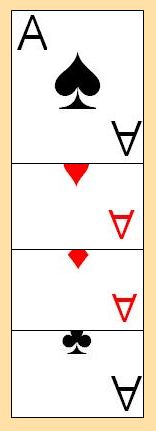
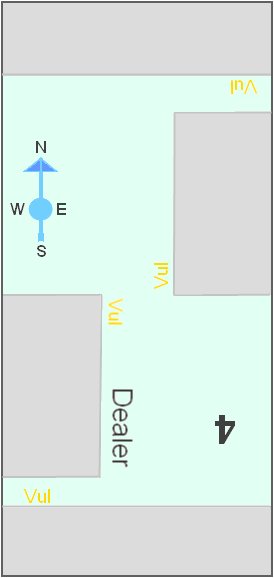
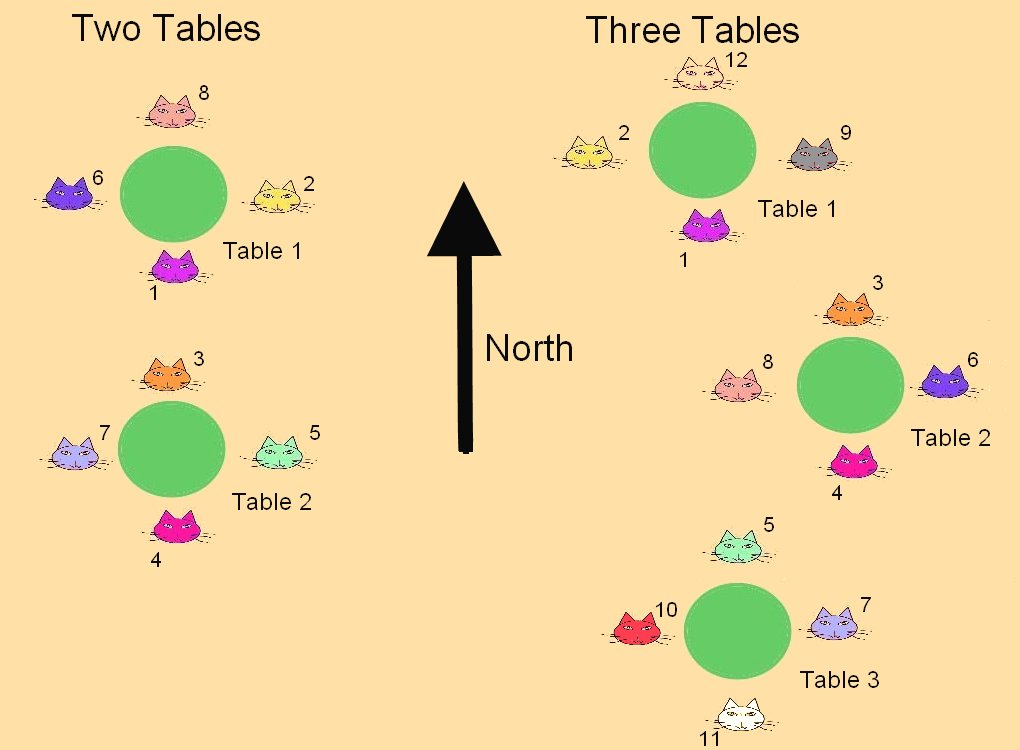 The most common competition format is individual players, usually consisting of a smaller and more casual Duplicate Bridge session, consisting of 8 or 12 players (two or three tables) each playing independently. In these cases, the players themselves would change seats or tables between rounds. The game is arranged in such a manner that each player would play as partner with every other player one time and as an opponent against each other player twice. At the start of such a game, each player would randomly draw or receive a card or slip of paper which would assign that participant his player number for the duration of the competition. The number drawn would then determine that players starting position, table and other pertinent information. Each table would play the exact same set of boards for the game, thus each table would essentially be playing identical hands of Bridge (albeit with a different set of players and different order of the hands). Between hands, the boards would be transferred between tables.
The most common competition format is individual players, usually consisting of a smaller and more casual Duplicate Bridge session, consisting of 8 or 12 players (two or three tables) each playing independently. In these cases, the players themselves would change seats or tables between rounds. The game is arranged in such a manner that each player would play as partner with every other player one time and as an opponent against each other player twice. At the start of such a game, each player would randomly draw or receive a card or slip of paper which would assign that participant his player number for the duration of the competition. The number drawn would then determine that players starting position, table and other pertinent information. Each table would play the exact same set of boards for the game, thus each table would essentially be playing identical hands of Bridge (albeit with a different set of players and different order of the hands). Between hands, the boards would be transferred between tables.
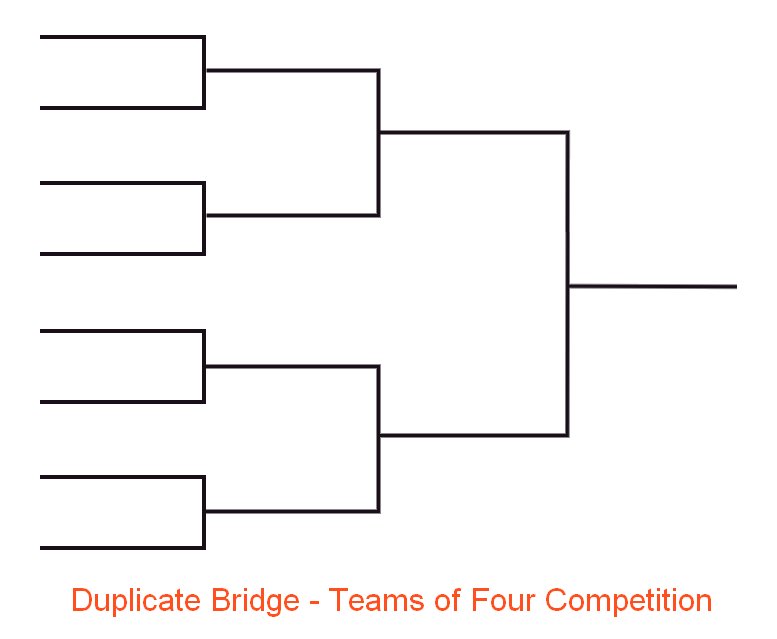 The last commonly used Duplicate Bridge competition format is Teams of four competition. In this format, players are first arranged into teams of four players. These teams are often preselected before the competition but may also be randomly arranged as per the method described for individual play. Two of the players from the team of four are sat in the North-South position of one table and the other two players of the team would be at the East-West position of a different table. Both these tables should play the exact same set of boards. At the end of a round, the sum total of both partnerships in the team of four are
totaled to determine the team of fours total score for the round. In this competition format, the winning teams usually then to the next round until the game is down to just two teams, who then vie to be the top team of four.
The last commonly used Duplicate Bridge competition format is Teams of four competition. In this format, players are first arranged into teams of four players. These teams are often preselected before the competition but may also be randomly arranged as per the method described for individual play. Two of the players from the team of four are sat in the North-South position of one table and the other two players of the team would be at the East-West position of a different table. Both these tables should play the exact same set of boards. At the end of a round, the sum total of both partnerships in the team of four are
totaled to determine the team of fours total score for the round. In this competition format, the winning teams usually then to the next round until the game is down to just two teams, who then vie to be the top team of four.
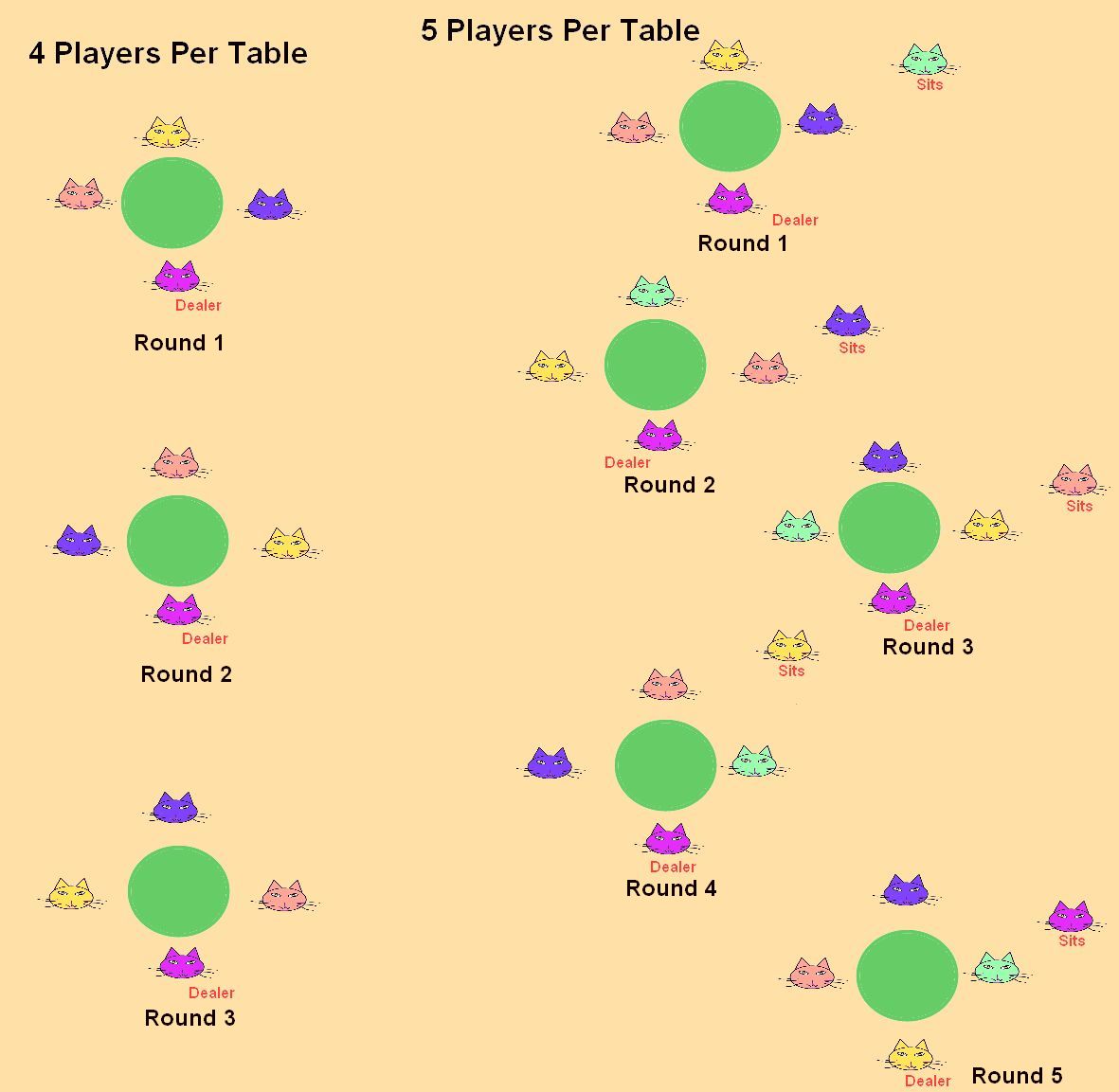
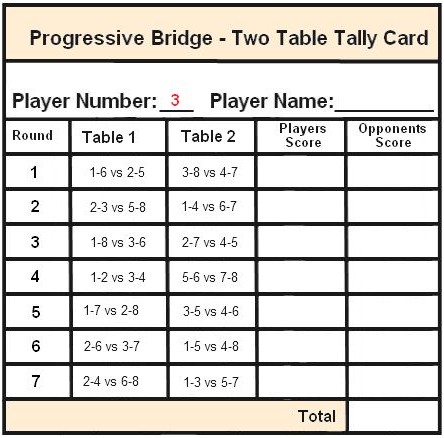

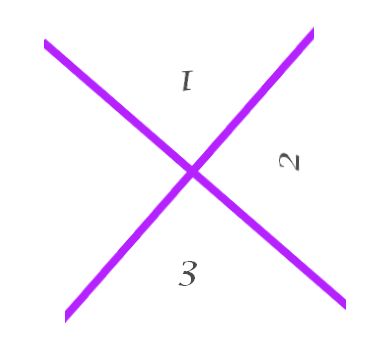
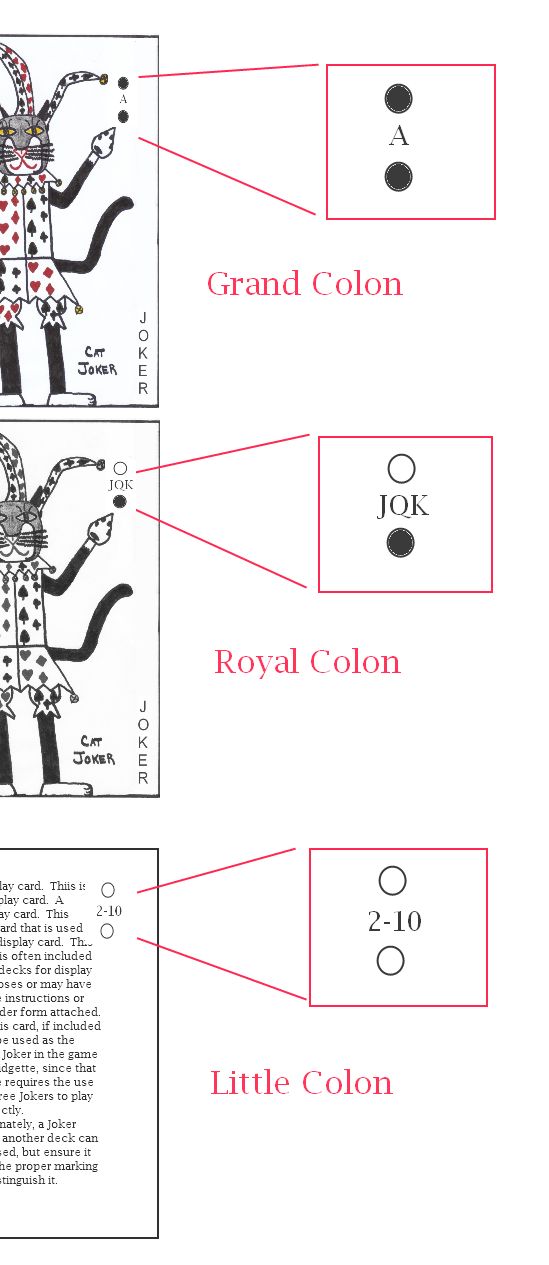
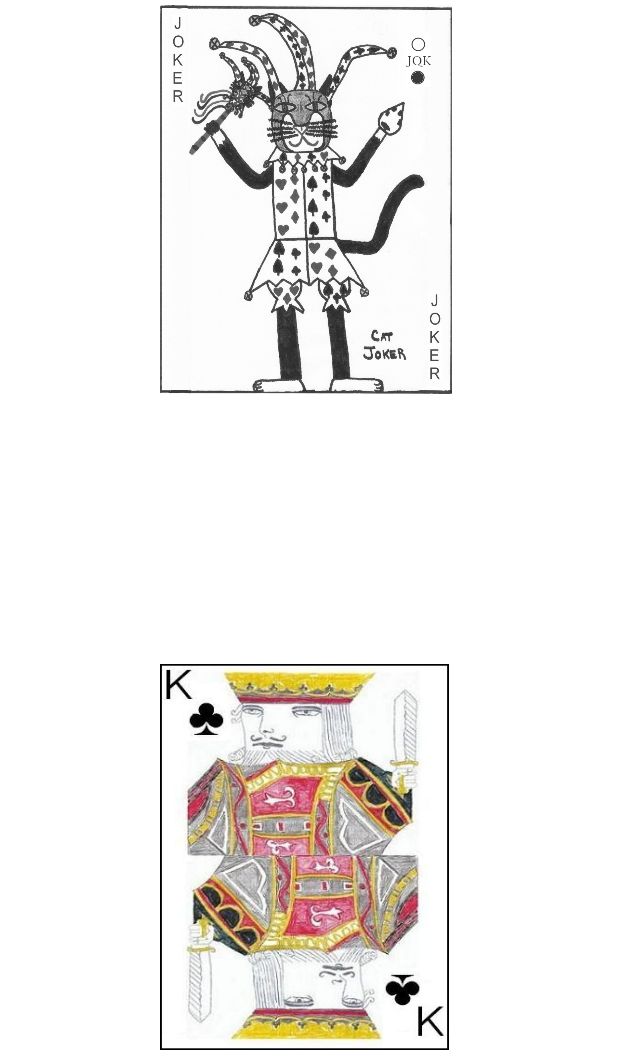
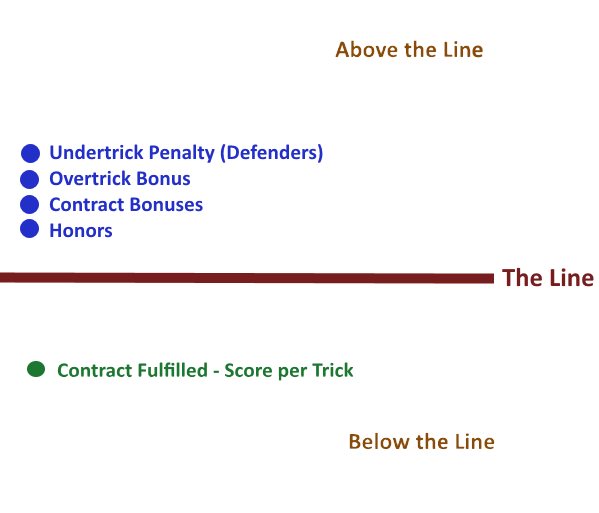 Once a team manages to accumulate 160 or more points below the line at the
end of a hand, they are said to have won a game. As in Contract Bridge, after
winning one game a team is said to be vulnerable. Once a team wins two games,
they are said to have completed the rubber. The team that wins a rubber (two
"games") earns a bonus score of 500 points (above the line) if the opposing team
has won one "game" or 700 if the opponent's team has not yet won a "game".
Once a team manages to accumulate 160 or more points below the line at the
end of a hand, they are said to have won a game. As in Contract Bridge, after
winning one game a team is said to be vulnerable. Once a team wins two games,
they are said to have completed the rubber. The team that wins a rubber (two
"games") earns a bonus score of 500 points (above the line) if the opposing team
has won one "game" or 700 if the opponent's team has not yet won a "game".
 The differences from Rex Bridge to Contract Bridge are
various differences in scoring, the inclusion of a new bid type, and an allowance of bidding above the level of seven
odd tricks. The following sections detail these changes:
The differences from Rex Bridge to Contract Bridge are
various differences in scoring, the inclusion of a new bid type, and an allowance of bidding above the level of seven
odd tricks. The following sections detail these changes:







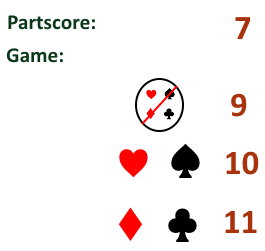
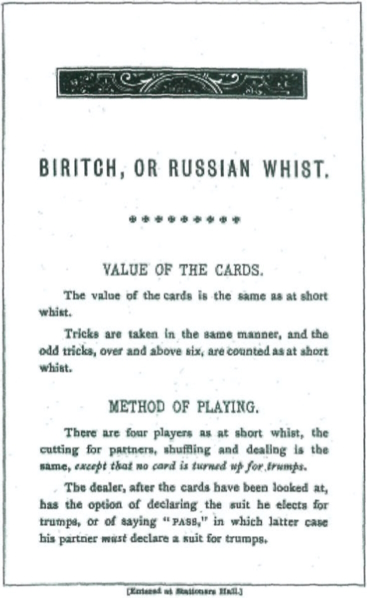
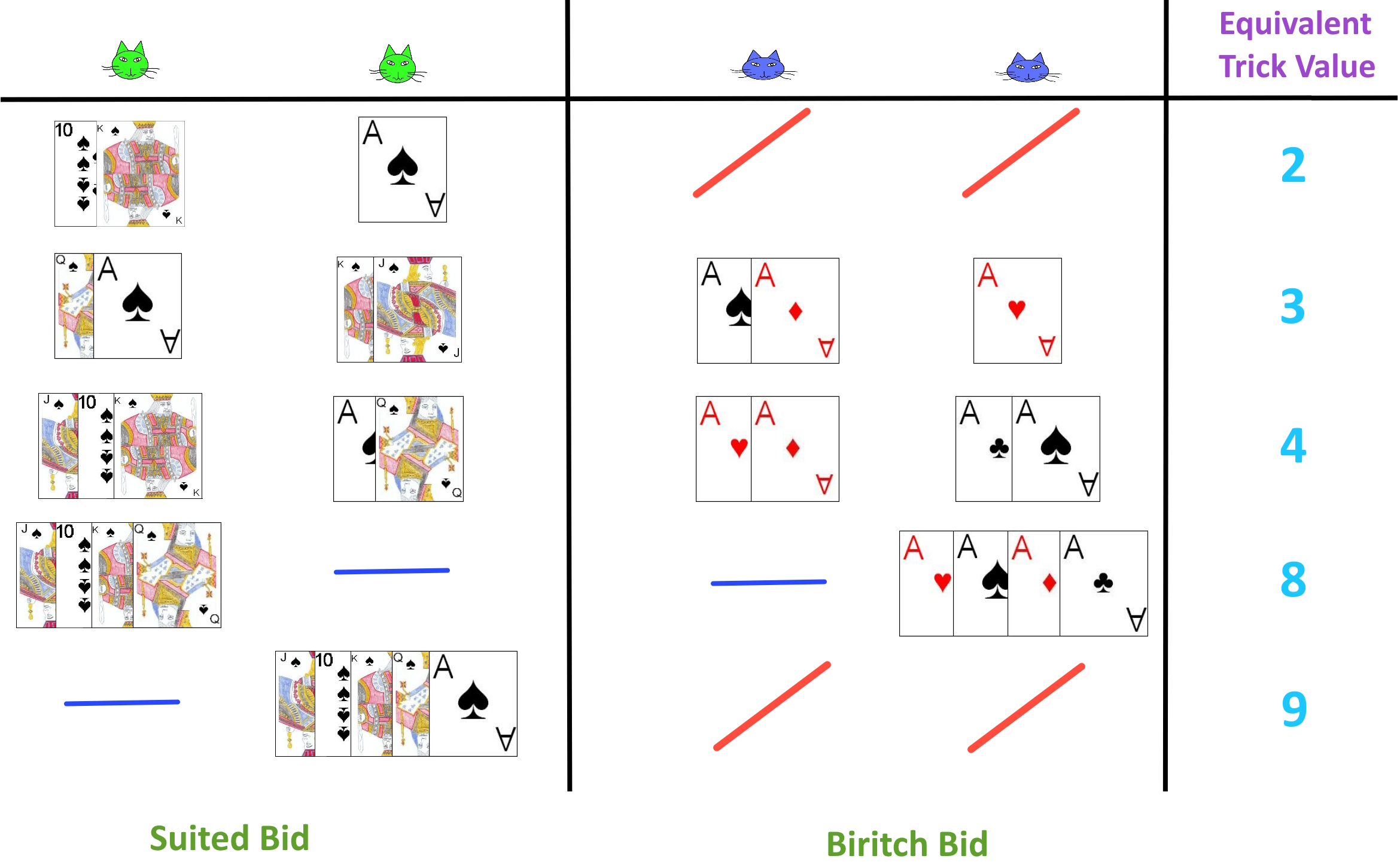 As mentioned previously, there are also bonus scores which can be won during the game for honours. These scores, however, are not considered part of the play score and thus do not count towards the 30 points needed to win a "game". The Honours scores are equivalent to the specific base value of each trick for that hand (not counting any Contre or Sur Contre that may have been declared during that hand). If the hand featured the use of one of the four suits set as the trump suit the following are the possible honours that can be scored on the hand:
As mentioned previously, there are also bonus scores which can be won during the game for honours. These scores, however, are not considered part of the play score and thus do not count towards the 30 points needed to win a "game". The Honours scores are equivalent to the specific base value of each trick for that hand (not counting any Contre or Sur Contre that may have been declared during that hand). If the hand featured the use of one of the four suits set as the trump suit the following are the possible honours that can be scored on the hand: